Paper Doll
Paper Doll & Real Simple Organize Dorm Rooms: SUPER-EXTENDED Edition
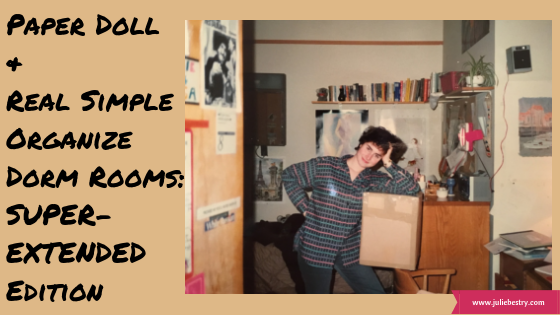
This post originally appeared in September of 2018. The links and prices have been updated as of July 2024.
Happy new school year!
I am very excited to have been interviewed again by Real Simple Magazine, this time about How To Make the Most of a Dorm Room, According to a Professional Organizer. (If you get the print copy, it’s page 52.)
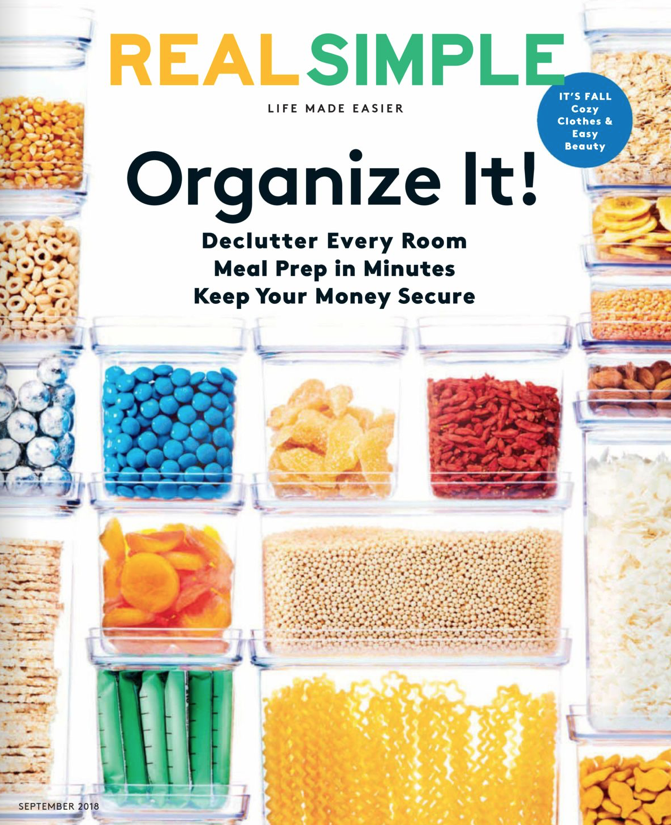
Longtime readers of the blog know that everything I need to say on any given topic can’t be contained on one page of a magazine, so I’d love to share the rest of my advice with you today.
Whether you are a student or you just dropped yours off at college last week, dorms (and other small living spaces) offer an opportunity to minimize without being altogether minimalistic, to be practical without giving up style. And be assured that it’s not too late, parents. Your college kids will be home for Fall Break or Thanksgiving, giving you the opportunity to surprise them with room improvement assistance.
Thirty-three years (and a few days ago), Paper Doll was a college freshman, far above Cayuga’s waters. For most of my life, I had a bedroom and a bathroom to myself, and (long before my professional organizing days), an entire house as an extension of my “space” to keep my stuff. Having a roommate, and sharing a bathroom with five other young women, all in a space smaller than what I’d previously had to myself was an education!
A dorm room has to serve as a study lounge, sleeping area, kitchenette, exercise room, and more, but space is at a premium. Keep surfaces clear and the clutter at bay with these organizing essentials.
MAXIMIZE VERTICAL SPACE
Declutter doom room floors and desktops by maximizing underused vertical surfaces. You can create DIY organization with corkboards, available by the board, tile, or roll.
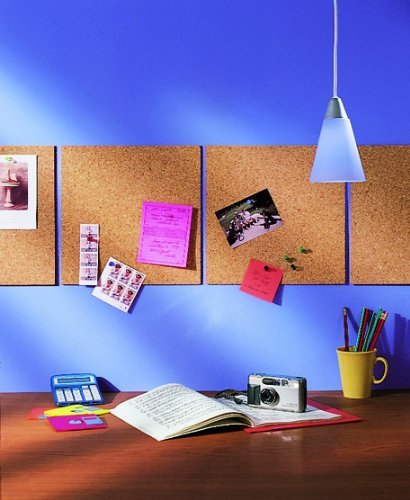
Pegboards are another do-it-yourself option, especially if you can’t use adhesive on your walls. Hang colorful pegboards from the ceiling, flush against the wall, and then add the hardware – hooks, baskets, and even small bulletin boards.
For students who want to upgrade (or who have no visual artistic talent, like Paper Doll), the attractive and sturdy Copper Wire Wall Grid uses re-positionable hooks, shelves, and baskets.
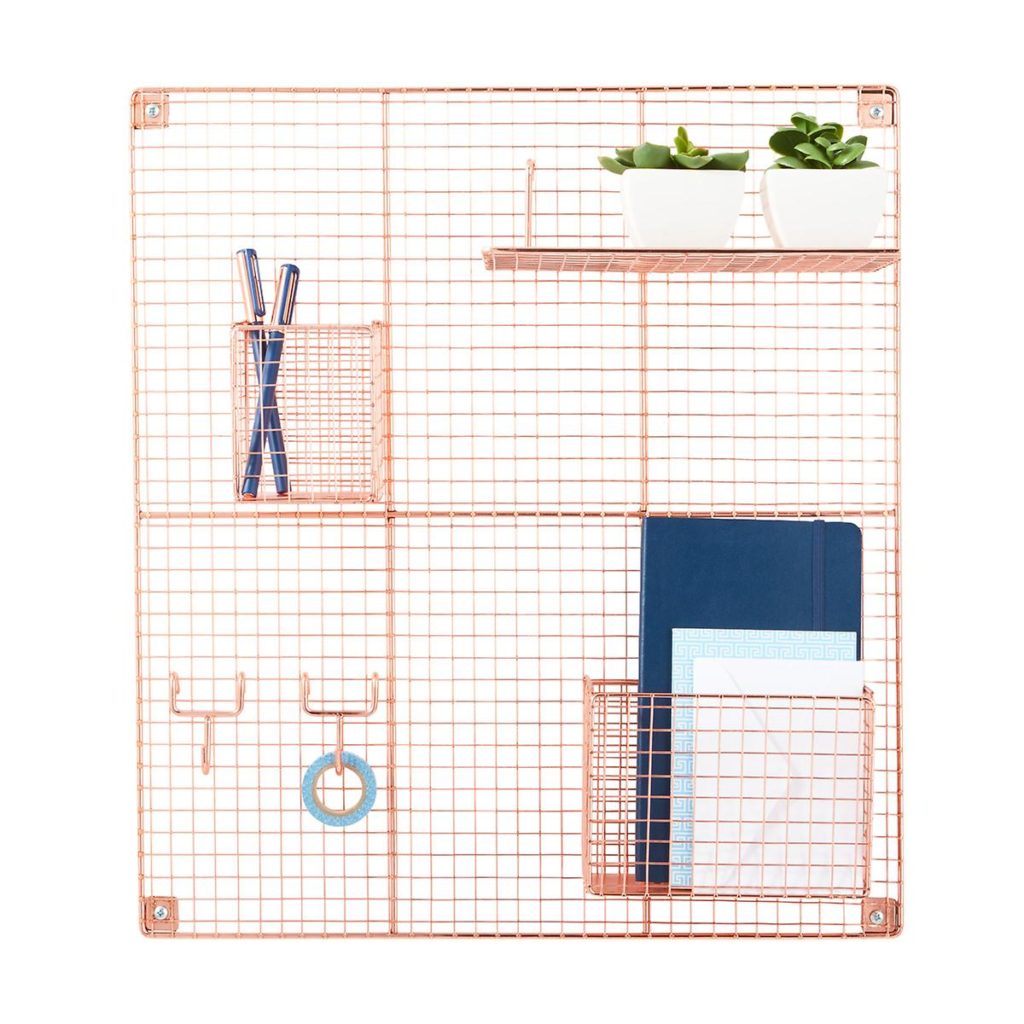
[Editor’s Note: Since this post was published in 2018, The Container Store stopped carrying this product. You can find a similar grid and accessories at Amazon.)
The same amazing 3M Command-brand hooks that help you keep track of keys and jackets at your house can do wonders in dorm rooms and bathrooms. Attach Command hooks, strips, and decorator clips to walls and doors to hang coats and clothing, hair dryers and jewelry, headphones, photos and tapestries without fear of damage to paint or finishes. (Command.com)
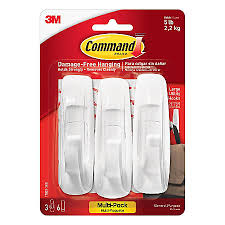
When you need more than desk space for your brilliant ideas, repositionable whiteboard sheets stick to the wall with static and let you write or draw. Snap a photo and send it to Evernote to preserve your brilliance, and then erase when it’s time to move to the next problem set. (White or clear from WizardWall.com or Amazon, from $42.)
REVEAL HIDDEN STORAGE
These sturdy bed risers with outlets and USB chargers let you reveal the possibilities of under-bed storage, from nylon duffel bags for corralling bedding and towels to storage tubs for off-season clothes. (Available at Amazon, and most big box stores, usually around $40.) The risers come in a variety of styles, but none are what you’d call fashion-forward, so also consider a long bed-skirt if you want to keep your bed high and at the height of fashion.
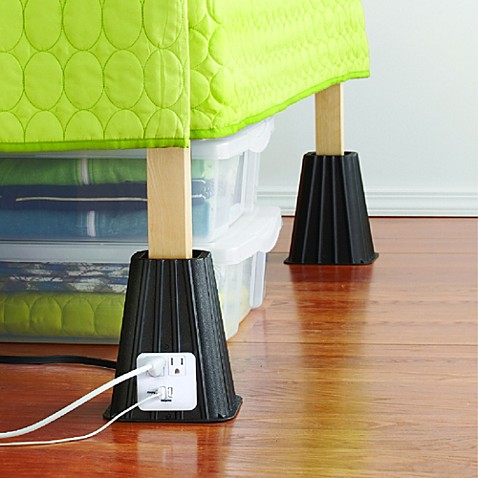
OVER-THE-DOOR ISN’T JUST FOR SHOES ANYMORE
Over-the-door shoe organizers keep your kicks (that’s apparently what they call sneakers these days!) from crowding a tiny dorm wardrobe’s floor, but the concept works for everything from hair care products to cleaning supplies to lingerie.
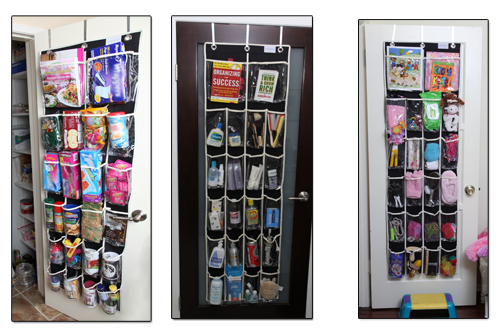
For those with suite-style bathrooms, swap your shower caddy for a hanging mesh shower pocket organizer to keep toiletries handy. (Amazon or CampingWorld.com, about $8-$11)
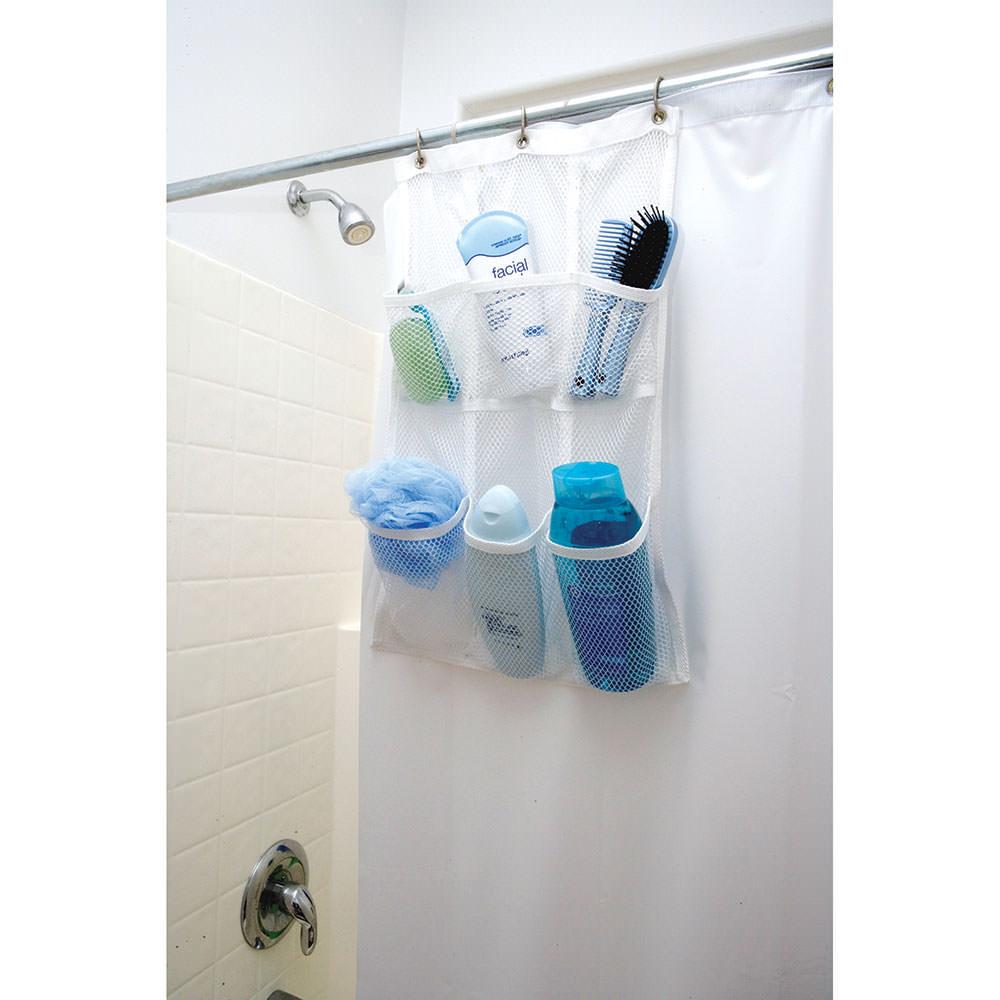
FOCUS ON PRIME REAL ESTATE
When there’s no room for a bedside table, keep everything you use (or should use) close at hand. Store your phone, tablet, glasses, tissues, highlighters, and spare notebooks in the unused space hugging your bed with any of a wide variety of bedside storage caddies. Check Wayfair for this colorful option, or Amazon for longer options, like the Whitmor Bedskirt Organizer, both around $20.
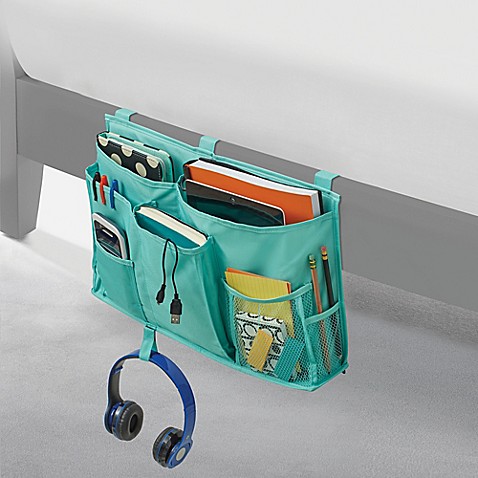
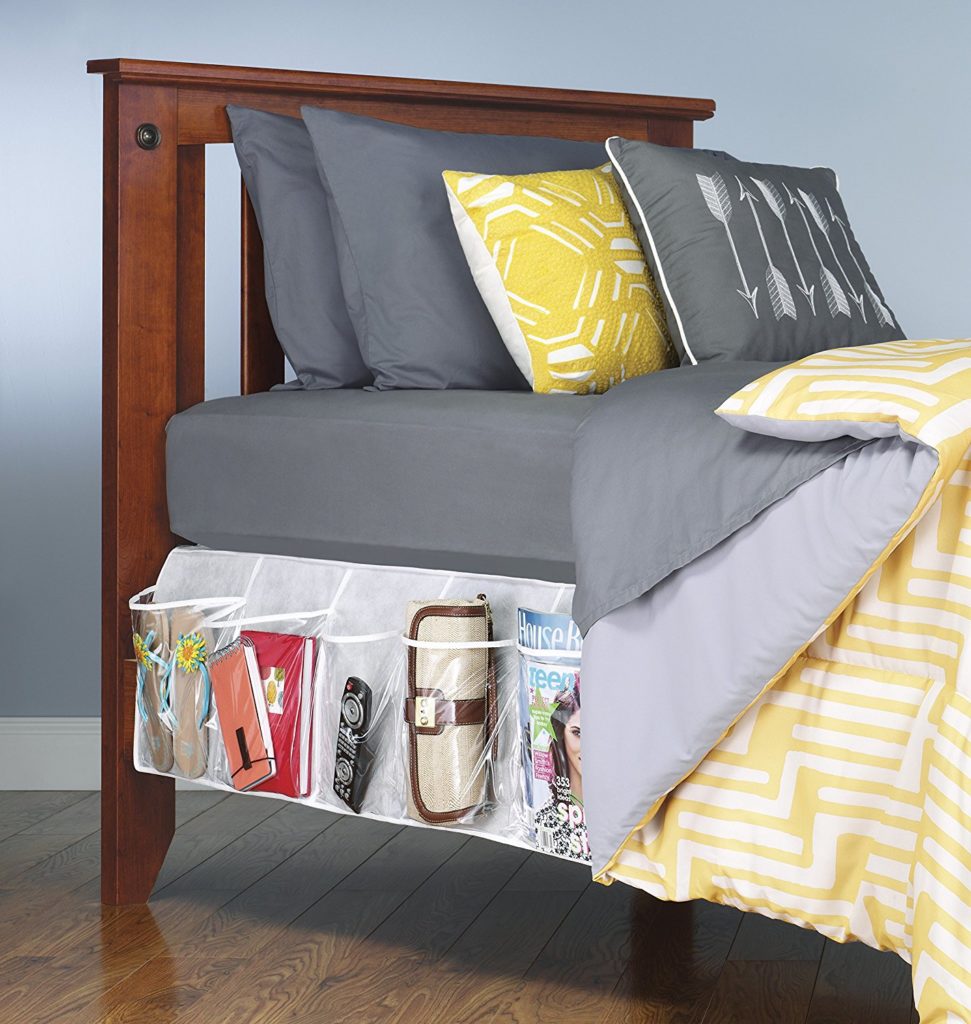
Don’t waste the space on the top of your mini-fridge. Let a Mini Fridge Caddy for about $19) hug your fridge to give you space for dishes and cutlery, and use that prime real estate for a milk crate storage box (Walmart) with hanging file rails to store papers or use as a snack pantry. (You might be able to create your own version; Paper Mommy and I were more inclined to shop than sew.)
Organize Pretty, Playful Parties (and Messages) with Paperless Post
Last month, I was approached by a representative of Paperless Post* to see if I might like to look at their offerings and perhaps share with Paper Doll readers. My first thought was, “Haven’t I already written about Paperless Post?”
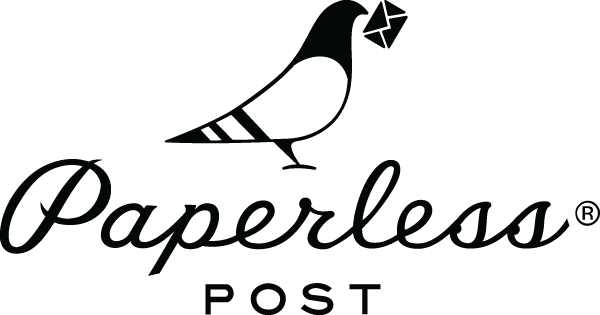
And yep, I had. But it was in 2012! I’d written Paper Doll on Paperless vs. Less Paper: Send to Kindle, iPrint, and Paperless Post. Since that post went live, Rover Curiosity landed on Mars, we learned what twerking was, royal bathrobe model Prince George was born, the word “selfie” hadn’t yet been added to the dictionary, and nobody had asked, “What Does the Fox Say?”
Things have changed a lot since 2012, and so has Paperless Post. Back in 2009, the company started developing ways to provide aesthetically appealing invitations online. Nowadays, that not necessarily any big whoop, but back then, it was fairly novel.
Imagine it’s set to be a beautiful weekend and the strawberries on your estate are ripe for the picking. It occurs to you to invite everyone in your little village to a strawberry-picking party: the secret object of your affections, a former nanny and a too-popular-for-his-own-good gentleman (whom you suspect are having a secret romance), local (if annoying) newlyweds, and the nanny’s loquacious but long-suffering aunt. (Yes, this is the Box Hill picnic scene in the Jane Austen novel Emma, but let’s go with it.)
You could send invitations by mail, but they wouldn’t get to everyone in time. You could create a Facebook post, but the nanny’s aunt is mad at Zuckerberg, and anyway, Facebook just doesn’t meet your aesthetic tastes. So what do you do? You create online invitations that can get to everyone two seconds after you design them, and get your RSVP’s in real time. No stamps and no schlepping off to the post office when you could be planning a strawberry-themed picnic menu.
THE DETAILS
Not planning any parties, Austenesque or otherwise, I focused on Paperless Post’s online card offerings, and sent one to see how the process worked.
After sending, I went to my email inbox and saw a miniaturized version of the front of the card I’d sent with options to view the tracking (to see who had received it), read and reply to any comments, edit it, and even add new recipients.

According to the recipient of the above card, his email showed a picture of the envelope with the top third of the card peeking out. (When I created the card, I had the option of eschewing an envelope or picking a different color interior liner, and I could have addressed the envelope, but the whole advantage of online cards is that you’re more likely to be able to find someone’s email address than street address these days.)
If I click on “View the card,” I can see what the recipient can see. The card sort of jumps out of the envelope, and the envelope moves to the edge of the screen; the center of the screen is given over to the front of the card, which flips to the back to reveal the message. Clicking a tiny swirling circle graphic lets you keep flipping between the front and the back. (In order to protect Phil’s privacy, you’re seeing a version going to me, from me.)
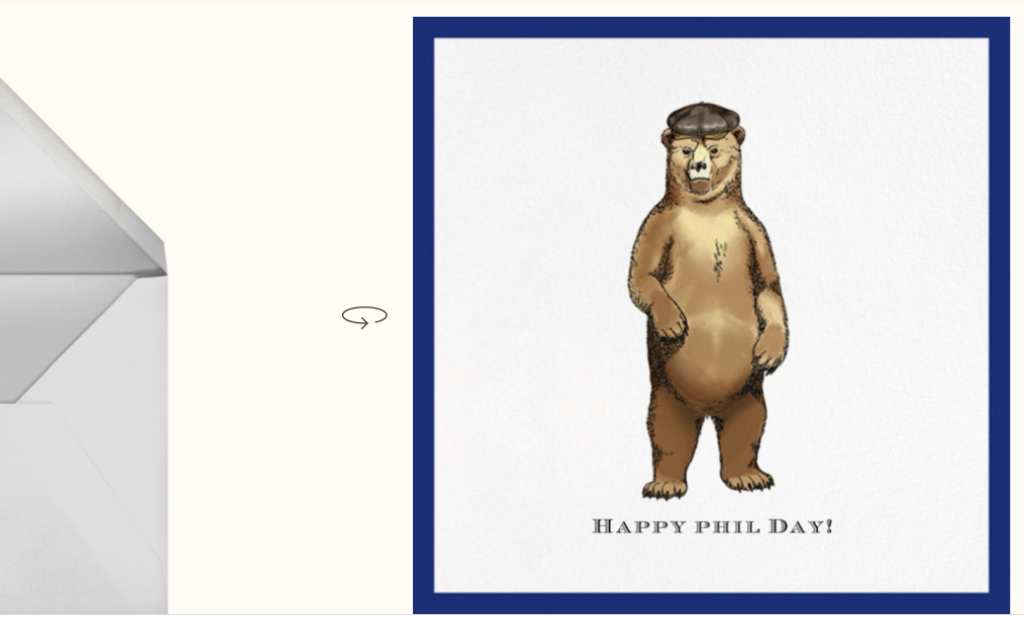
After this, I got a little giddy, sending cards to friends and to myself in order to get a complete sense of how things worked in Paperless Post. I sent a card to friend of the blog, Professional Daily Manager Nanette Duffey of Organized Instincts.
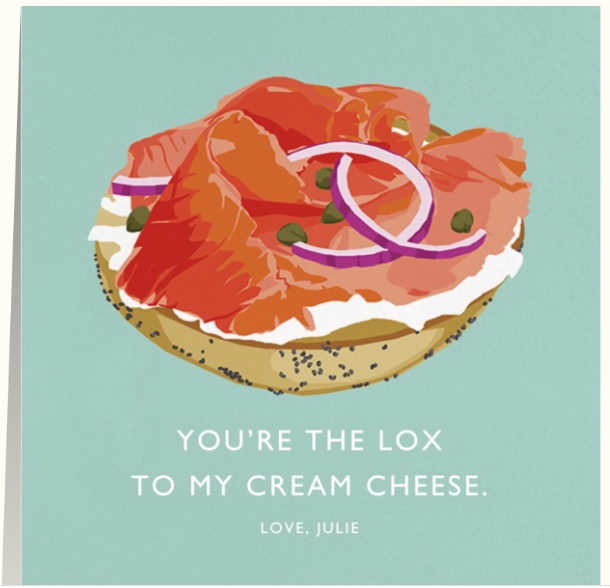
Then I sent one (thematically similar – I think it was lunchtime) to myself:
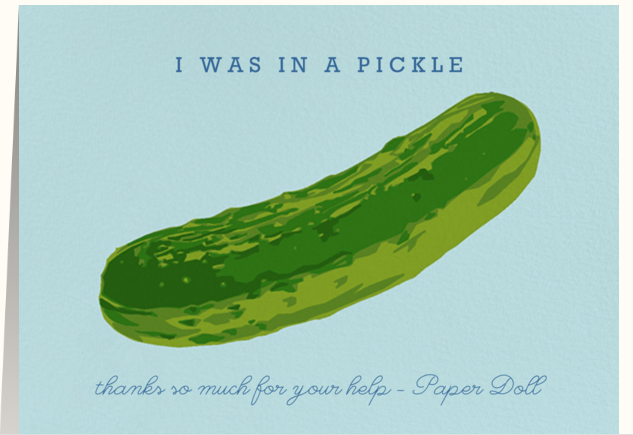
Paperless Post has gorgeous and fun creations that are just like what you’d find in some fancy, big city, high end stationers. It’s just not on paper. Wares include:
Greeting Cards – Got holidays? Because Paperless Post does. Their holidays cards cover: Rosh Hashanah, Diwali (seriously, when did you last see a good Diwali card?), Halloween, Thanksgiving, Hanukkah, Christmas/Holiday, Kwanzaa, New Year, Valentine’s Day, Lunar New Year, Purim (my personal favorite!), St. Patrick‘s Day, Easter, Mother’s Day, Father’s Day, and Ramadan.
They also have all-types-of-occasion cards designs including those for:
- Thank you
- Birthday
- Graduation
- Just because
- Congratulations
- Love and romance
- Sympathy
- Anniversary
- Apology (Why do so few people send apology cards? As an aside, check out the book, Why Won’t You Apologize?: Healing Big Betrayals and Everyday Hurts by Harriet Lerner. There is no better resource for organizing your thoughts surrounding giving and getting apologies.)
- Get well
- Good luck
- Encouragement
My favorites are the designs in Paperless Post’s Hello!Lucky line, which include cards, invitation, and stationery they describe as “playfully exuberant with a touch of mid-century nostalgia, the work of sisters Eunice and Sabrina Moyle exudes a childlike glee.”
Announcement Cards – for births, graduations, weddings, and moves
Thank You Notes – You did read my prior post, Gratitude, Mr. Rogers, and How To Organize a Thank You Note, right? Just look at the bevy of thank you note options!
Birthday Cards and Invitations – From the typical birthday cards for “him” or “her” and belated cards for adults and children to milestone birthdays to quinceañeras.
Wedding – Just got engaged? Paperless Post starts you off with a variety of Save the Date cards, moves you along to shower and party invitations, then invitations for the rehearsal dinner and wedding brunch, and finally actual wedding invitations.
Wedding hosts and guests are equally covered, with announcement cards, thank you notes, wedding party requests, and congratulatory notes.
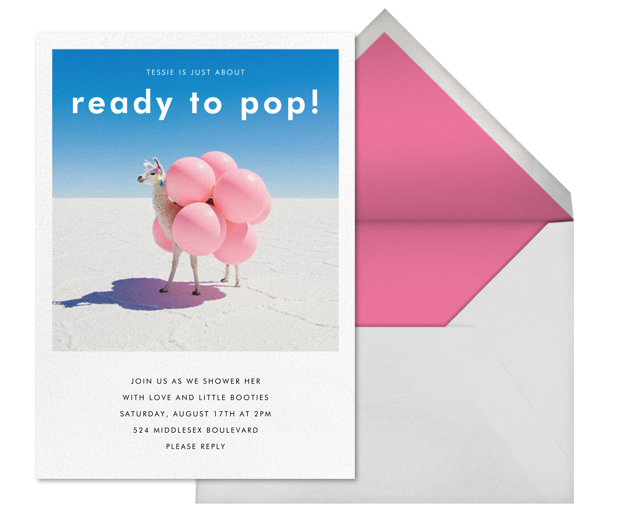
Invitations – This is where Paperless Post began, and they haven’t lost their mojo. There are far too many categories of Paperless Post invitation categories to even mention, but whether you want to have a 4th of July bash or cocktail party, a housewarming or a bar mitzvah, a political fundraiser or a Game of Thrones season finale viewing party, it’s all there. And it’s not just about the casual parties. There’s a whole “Professional” category for launches and charity events, holidays and retirement parties, and more.
Stationery – From personalized stationery that looks like what, on paper, we used to call informal cards to nice “stuff that classes up the joint” to children’s stationery, there are all manner of digital versions of the stationery that would likely just sit in your desk drawer if they were paper versions.
Flyers – This is a new feature, and seems perfect for the Instagram crowd. It’s a bit of a cross between an invitation and a web page, and it lets you create a site for your event and then use a shareable link to let guests know about it. Add the link to display it on social media, or send it to your whole email list (or a few favored guests) or in text messages. Guests can RSVP directly from the flyer page so you can keep track of the expected turnout and figure out how many canapés to have the caterer make (or how many pizzas to order).
The snazzy professional designs make it simple to create an event page filled with all the necessary details while still creating a .gif or photo buzz. Choose your color palette, select page styles and cool text effects, and then just input the event details and don’t even worry about having enough space. You can use as much text as you want, and even add travel directions, hyperlinks, and whatever else your peeps need to know. (For a limited time, the Flyer option is free, so if you’ve got any special events on the horizon, or want to throw a quickie Independence Day bash, here’s your shot.)
WHAT IF YOU WANT PAPER CARDS AND INVITATIONS?
Paperless Post has partnered exclusively with Paper Source to print a curated collection of paper cards and invitations for weddings and holidays, as well as stationery for those wanting to embrace the handwritten writing habit.
OFF-THE-RACK, CUSTOMIZED OR DIY
Search by card shape, color, cost, and designer. Want Oscar de la Renta? Crane and Co? Marimekko? It’s all there.
Prefer to make your own masterpiece? With many cards, you can choose to upload your own photo and even modify the typefaces and font colors. You can replace the original message with something of your own. For example, the bear card up there? It was presented as a Father’s Day card, but I knew my friend Phil would like the bear, so I invented a holiday: Phil Day!
HOW PAYMENT WORKS
Paperless Post has developed its own currency. It’s not quite Bitcoin, but it is coin. Instead of buying each individual card, you purchase some dollar value to fill your account, and then each card type has an assigned coin value. As you create and send cards, the value in your account decreases, like a credit line at Oleson’s Mercantile on Little House on the Prairie.
Some items are free to send, while others require coins. Beyond premium card designs, there are premium add-ons, ranging from envelopes, liners, “stamps,” postmarks, logos, and backdrops, all of which require coins. They call this “the customization flow,” and as you add features, the cost of your card (per recipient) shows up in the top right corner of the screen.
Paperless Post sells coins in packages, and the price per coin varies based on the size of the package, so there are discounts as you increase the package size. For instance, 20 coins for $10; see all the coin packages here. Coins are non-refundable, non-transferrable, and expire after of five years of account inactivity, so I advise loading up a small batch up coins, playing around, and giving yourself the option to add more later.
WHAT’S MISSING?
Paperless Post is gorgeous. It’s a visual delight filled with options. It’s reasonably priced. It’s innovative. However, I found that it wasn’t always intuitive. The site seems to assume it’s so easy that you don’t need instructions, which may be true for their younger, hipper target audience. (I’m not so young and was never hip.) The best way to cope is to let the site wash over you. Pick what you want from the menu at the top. Select colors and styles. If you, like me, want to dig deep and know all the options before you get started, head to the Help Center.
You also might want to download the mobile Paperless Post app, which I used on my iPad during the week my Mac’s hard drive was DOA. I found using the app to be fairly seamless, and it actually worked better for me than when I’d used my primary browser (Safari) which sometimes took me to error pages.
PARTY ON
This may seem like an atypical post for Paper Doll, but as I mentioned in my prior post on thank you notes, I’m a big believer in gratitude (and conviviality) for raising the spirits of all concerned, and using a service like Paperless Post lets you quickly commiserate with a co-worker who is out with the flu, invite friends to an impromptu pizza party, or thank someone for being your hero, no matter the weather or your personal card inventory. What could be more organized than having a resource at your fingertips that doesn’t even require maintaining your own inventory?
*DISCLAIMER: In return for writing an honest review of my experience, Paperless Post loaded my account with a coin package to use for testing the selection, design, purchase, and sending and receiving experiences. The opinions are my own (and who else would claim them, or insert Jane Austen into them?), and Paperless Post received no guarantee of review content.
Gratitude, Mr. Rogers, and How To Organize a Thank You Note
I still write thank you notes.
There, I said it. Apparently, this makes me old-fashioned. But maybe you’re old-fashioned, too? Maybe you love showing the people who are kind to you that you appreciate their efforts, their generosity, or their innate value as human beings. And hey, Mr. Rogers wrote thank you notes (remember, he wrote one to Mr. McFeely?), and Mr. Rogers the coolest thing right now.
I fully admit that I haven’t hand-written a regular letter in at least ten years, and probably have written no more than a handful in the past twenty years. But a thank you note? Well, Paper Mommy taught me well.
Some people remember childhoods being forced to sit, glumly, prevented from playing with new presents until a thank you note was sent to Aunt Gertrude for the itchy sweater. Some of us (ahem, even in the second half our centuries on earth) are prodded with, “And of course you wrote a thank you note, right?” (Yes, Paper Mommy.) But the concept of a thank you note should be imbued with the delight of appreciation, not the weight of obligation.
I’m not sure I even appreciated the value of a thank you note until I was in my 30s and realized I’d slowly stopped receiving them. But thank you notes are great. Think of all the emotional heft given to the importance of gratitude journals:
The Benefits of a Gratitude Journal and How to Maintain One
Gratitude Journal: 67 Templates, Ideas, and Apps for Your Diary
Turn Pain to Joy: 11 Tips for a Powerful Gratitude Journal
The Ultimate Guide to Keeping a Gratitude Journal
120 Gratitude Journal Prompts to Create More Thankfulness in Your Life

If gratitude is good for us, if it helps us see things in a more positive light, imagine how much it could do for the objects of our gratitude, the people who give us reasons to be grateful!
Not to worry; this post isn’t a guilt trip for those who don’t write them. It’s a guidepost for how to quickly show your gratitude and get on with your life even when you rarely write something without a keyboard or phone in hand.
ORGANIZE YOUR THANK YOU NOTE
You already know how to write “Dear Ms. So-and-So” or “Hi, BFF!” And I’m sure you have a sense of when it’s appropriate to sign with “Best regards, Chris” vs. “In gratitude, Jane” vs. “xoxoxox, Pookie.” (And yes, your BFF will probably be delighted to get an actual thank you note from her Pookie.)
- Start with gratitude. “Thank you.” Whether someone writes, “Thank you for the book” or “I am so appreciative of the time you took to explain the new credentialing rules,” recipients know they are being valued. Warm, meet fuzzy.
- Mention details. If you like the gift, you can say, “This is the perfect deelybopper and I’m so excited to have it.” If you don’t like it, say, “I’ve never seen anything with such intricate detailing.”
- Allude to the future. Anything from “The book is on the top of my to-read pile for my vacation” to “I will keep the advice you gave me at dinner in my mind as I choose my future school/career/mate/car.” (It doesn’t say you’ll follow the advice, and only you have to know that the truth is you’ll be remembering that advice so you can take the opposite path.)
- End with gratitude. Some things bear repeating.
For an informal thank you note, that’s all that’s needed. (For a more formal letter, you will add a more formal salutation and signature, and flesh out each of those points into a brief paragraph, but it’s all the same theory.)

ORGANIZE YOUR THANK YOU NOTE ACCESSORIES
In order to send a thank you note, you need three more things:
- The recipient’s address
For some of us, managing writing the thank you note is easy, but finding where to send it may keep you from writing post-Christmas thank you notes until July. Please don’t depend on having saved the envelope from a birthday card to find a return address months later.
Address books are great if you’re under 20; beyond that, you likely have hometown friends, college friends, colleagues from prior workplaces, current networking contacts, and so on. You likely know too many people who move far too often to keep a paper address book that covers all contingencies.
I have a confession.
I never know my best friend’s address. She and I haven’t lived in the same city for 30 years, and she moves much more often than I do. We talk on the phone a few times a week, text on most days, but since her children have grown and photos are digital, Amazon acts as our go-between for most tangible things. A few months ago, a thank you note I sent her was returned by the post office. She’d moved in August, and I sent the note to her old address. Because she’s my best friend, we laughed about it without cringing, but if your note to your spouse’s boss, thanking her for a lovely meal, got returned and you had to start all over again, you’d be groaning.
Pick ONE place where addresses will live. For me, even though I’m a paper doll, that’s my Apple Contacts app. Whether I’m on my Mac, iPhone, or iPad, everyone’s contact information is accessible. (I use Microsoft Outlook, which means I have an extra hoop through which to jump if I want to remember to add email addresses to physical addresses and phone numbers, but Contacts still works for me.)
Whether you keep a Google spreadsheet or an Evernote template or a document in Dropbox or use your iOS or Android system for keeping everything synced, create a system for maintaining people’s addresses. Update it every time someone moves, or maybe have Siri or Alexa remind you to tweet or post a Facebook message on the 17th of whatever month you choose, each year, to say, “Hey, if you’ve moved in the last year, text me your address so I absolutely have it!” Better safe than sorry.
- Stationery
Most people fall into one of two camps: there’s either nothing in their house nicer than the back of a receipt and an unused electric company payment envelope or there are piles and boxes and bags of greeting cards tucked all over the house. (We professional organizers truly have seen it all!) To make sure you have WHAT you need WHEN you need it, check out this classic Paper Doll post:
Paper Manners Matter: Cut Card Clutter & Store Social Stationery
(And shhhh, don’t tell anyone, but I’ve started purchasing some very pretty card packs from the dollar store near my house. Eight cards for a dollar mean that unless you are really, really popular, you can inexpensively go the better part of the year without having to yield to the temptations of a card shop.)
- Postage
My post office is within walking distance of my house, but if getting to a post office is inconvenient for you, you can purchase stamps online. (Perhaps not surprisingly, even from Amazon.) Be forewarned, the post office arranges stamps by their names for the individual themes, and they aren’t always obvious. I was looking for my recent favorites, stamps with drawings of various types of Mexican food, but was having no luck searching “Mexican food,” “food,” etc. I recently went to dinner with my Nashville colleague, Liz Jenkins, CPO® (owner of A Fresh Space) and her husband, and thought it would be fun to put an empanada or some flan on the envelope. (Edited: Found them! Look for Delicioso! Update: As of December 2019, this stamp is only available as a framed print.)
In fact, in researching this post, I found that the US Postal Service has a stamp honoring Mr. Rogers, and a sheet of 20 will now be finding its way to Paper Doll HQ.

All this said, thank you notes (or cards, or letters, or invitations) do not have to be sent through the mail. Sometimes, time is of the essence. Sometimes the weather outside is frightful, and the idea of going out to buy cards or invitations or stationery and then mailing what you’ve written is even more frightful. Sometimes you lack confidence in your handwriting.
That’s OK. Paper Doll has you covered. In our next post, we’re going to talk about Paperless Post, one of the snazzy ways to send your thoughts so they get there quickly without looking like every other newsletter, bank statement, and email in the inbox.

Until then, I thank you for being a Paper Doll reader, and truly appreciate the time you take reading my posts, whether you find them via Facebook, Twitter, your RSS reader, or from searching the web for a keyword that has nothing to do with what I’ve written about when I’ve made weird offhanded comments. (Admit it. You Googled deelybopper.) Until next time, Paper Doll is grateful for your readership, whether you’ve been around the whole eleven years or if this is your very first post.
NAPO2018: Paper Doll Explores Meori & the Glorious Goodies Within

In the last few posts, I explained that this year’s NAPO2018 was billed as a retreat instead of a conference and expo, and without an expo, I feared that I’d have no bounty of new products to share with you. However, thanks to our sponsors, even without an expo, I still have some goodies to present.
MEORI
At our welcome event, all conference attendees received a Meori foldable box absolutely filled to the brim with goodies. Mine was this Lava-Black-with-White-Flowers version, but Meori (a product I’d planned to profile this spring anyway), comes in a variety of gorgeous patterns and colors. That said, I couldn’t convince any of my colleagues to trade me this one for a Paper Doll-themed Midnight Magenta Meori box.
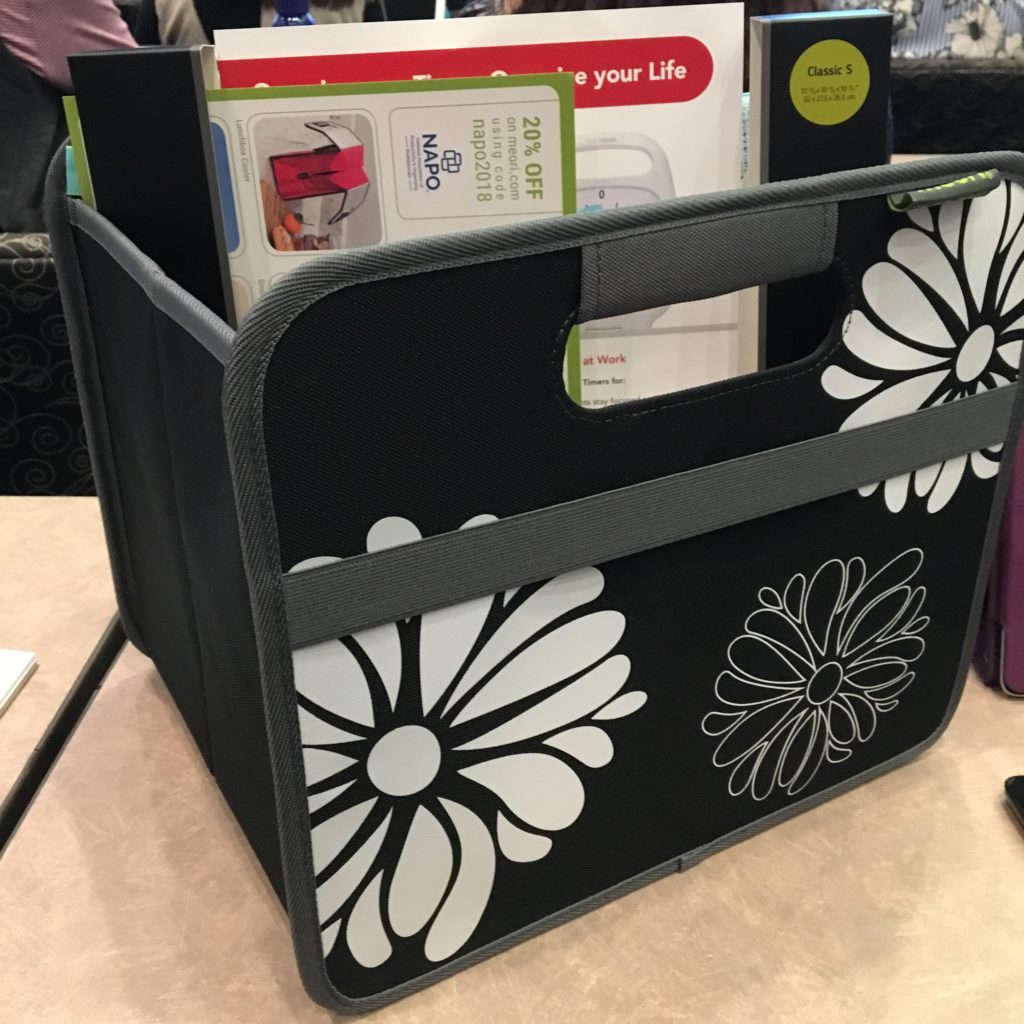
The Meori foldable boxes are made from high-grade, tear-proof, dirt-resistant polyester that you can wipe clean with a damp sponge. Did you know that the German word for “dirt-resistant” is schmutzabweisend? Boy, Meori’s packaging is educational!
All varieties fold or unfold in three easy steps to become a completely stable (but decorative) storage box secured with a wide elastic band. With the exception of the Mini, all styles hold up to 65 pounds! (Paper Doll does not advise having so much stuff in your Meori box that it turns into clutter you must cart around, but it’s nice to know that Meori is sturdy!)
The Classic Meori comes in four sizes and all have elastic mesh interior pockets.
Mini – The mini measures 5″ L x 6 1/2″ W x 5″ D, and is perfect for organizing teeny things in a bathroom, dorm room, school locker or car. The Minis come in Hibiscus Red (pictured below), Azure Blue, Marine Blue, Pink Berry, and Spring Green. ($12.99)
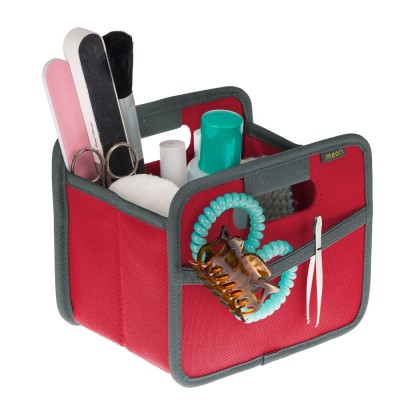
You can also purchase a shiny silver-finish wall mount for the Mini ($5.99) to keep things accessible on the back of a door or on a wall near where you’re heading out of the house. There’s also a collapsible Meori Mini Hanger in Marine Blue that lets you store three Minis vertically, hung from a velcro loop on the bar of your closet.
- Meori Mini Hanger
- Meori Mini Hanger – collapsed
Small – I was a little shocked to learn that my own Meori (pictured up top) is considered the Classic Small, because it’s fairly mighty. It measures 12 3/5″ L by 10 5/6″ W by 10 3/7″ D, and holds 4 gallons of whatever stuff you throw into it. (If those measurements seem odd, recognize Meori, a Japanese-themed German company, like most of the world, uses the metric system, and 32 x 27.5 x 26.5 cm sounds a bit less unwieldy.) The Small comes in 31 different color/pattern combinations in solids, polka dots, and flowers. ($25)
Medium – The Meori Medium comes in ten color/pattern combinations, with solids or star patterns, and measures 12 3/5″ W x 10 5/6″ H x 14 4/7″ D (again, it makes more sense in the metric system). It’s perfect for carting groceries or other shopping items (up to 6.5 gallons of goods) from cart to car to house and back out again. ($30)

Large – The Classic Large should probably be called the Double-Duty. It comes in 34 different color/pattern combinations, measures 19 3/4″ L x 12 3/4″ W x 10 3/4″ D, and has two interior compartments. It will hold 8 gallons of whatever you’ve got! ($35)
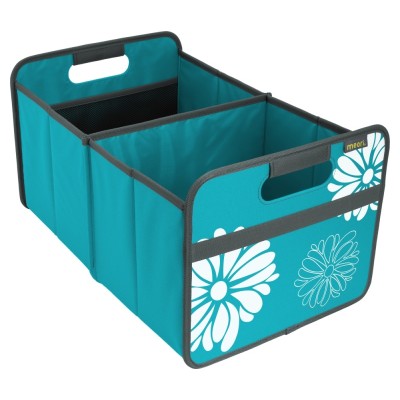
All of the Meori foldable boxes collapse down to between one and two inches thick, making them easy to ship or store when not in use.
Other Meori foldable boxes include:
Office – Measuring 12″ W x 13″ H x 12″ D, suitable for standard letter-sized folders, and able to hold up to 65 pounds, the Office Meori has built-in plastic file rails and a rewritable label. It’s ideal for mobile offices and workers who shuttle between locations, and folds down to 1 1/9″ when not in use. (For European readers, there’s also an Office A4 style.) Unfortunately, it only comes in Lava Black or Solid Grey, which is a shame given the rest of Meori’s bold color palette. ($40)
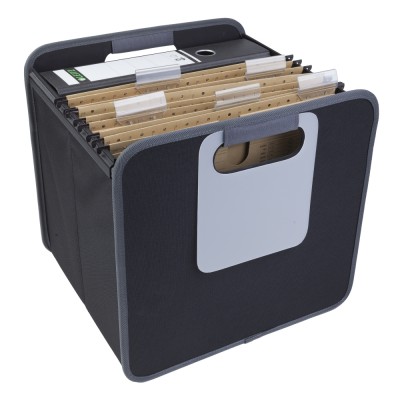
Outdoor – This outdoorsy version of the Meori has the same measurements as the Classic Large, but is made of water-repellent rip-stop fabric. Suitable for camping, sailing, picnics, and other outdoor adventures, it includes snap buttons and 4 metal grommets so you can secure it to a truck bed or tie it up to a boat. The Outdoor can be adjusted to use as two small boxes or one large one. ($42)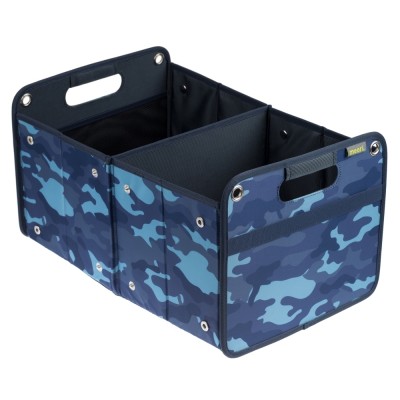
Meori has developed a line of accessories, including a 26″ padded, nylon carrying handle with metal hooks for use with the Small, Medium, and Large Classic foldable boxes, and a 56″ adjustable, nylon shoulder strap for use with the Small, Medium and Large Classic foldable boxes as well as the Office and Outdoor boxes. There are also covers for the Classic and Outdoor versions to protect your contents from rain, sleet, snow, dust – and, if you live in the southeastern US as I do – pollen!
If you’re looking for something to keep up with your snacking habits, Meori has a foldable cooling bag with a zipper that will fit in the Classic Small, Medium, and Large versions, and a tailgate carrier set with the Classic Large and the cooler, combined. The Picnicker fits in the Classic Small, Medium, and Large, and will secure four sets of (nesting) plates, cutlery, drinkware, and a cutting board. If you plan on taking some beverages along, Meori has 9- and 16-compartment expandable, padded bottle inserts.
Intrigued? Check out Meori’s site to find other attractive, durable, collapsible/foldable options, including 2-, 6-, and 12-bottle wine totes/carriers, insulated lunchbox cooler, hobby box, and more.
THE OTHER GOODIES
Our sponsors didn’t leave those Meori boxes empty. Inside, we had a bounty of useful items including:
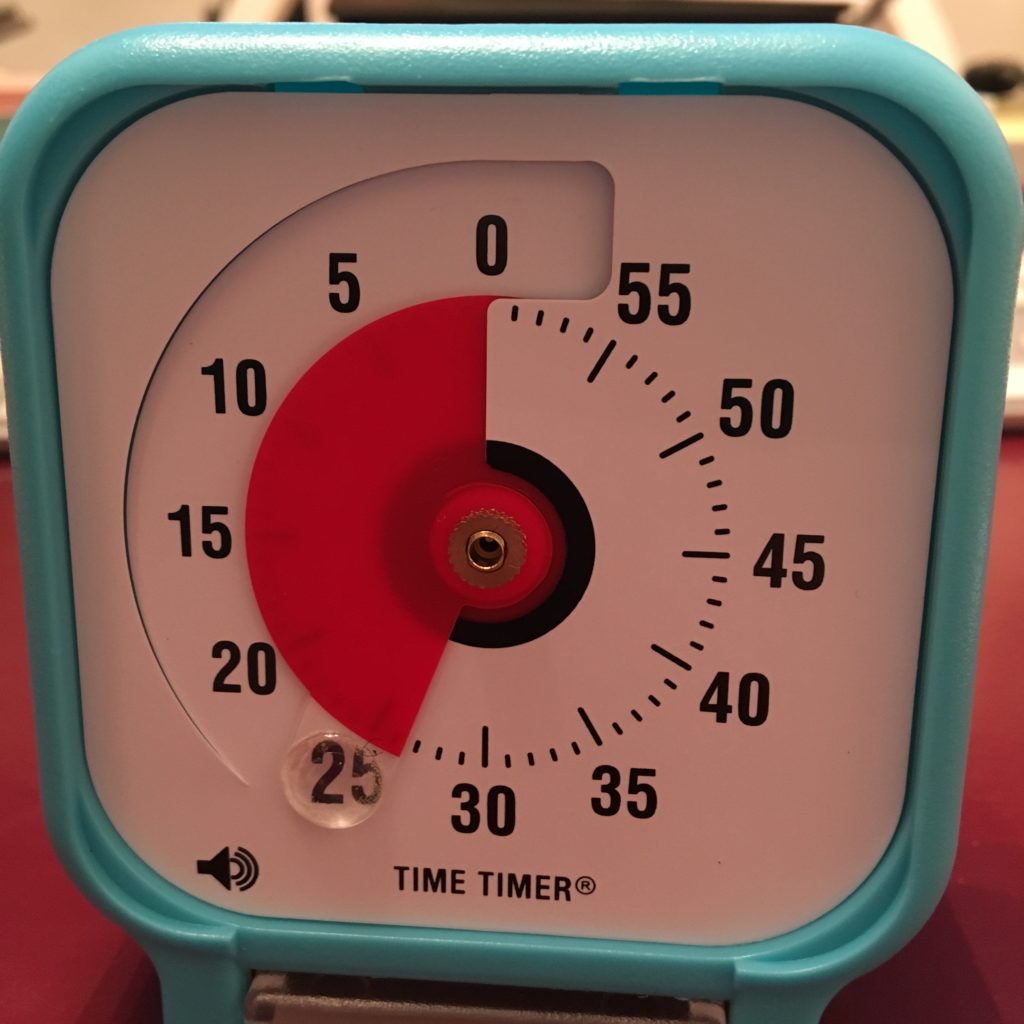
Last year, I wrote Paper Doll’s NAPO 2017 Recap: New Twists on Time Timer and I’ve repeatedly shared all the reasons to love all of the incarnations of Time Timer. My old (circa 2002) Time Timer has certainly been put through its paces over the years, so I’m excited to add this tiny 3-inch powerhouse to my procrastination-fighting arsenal.
Container Store Zippered Pouch
Our friends at Container Store gifted all NAPO2018 attendees a large, zippered pouch. Made of nylon mesh embedded in clear vinyl for reinforcement, it’s weather- and puncture-resistant, and perfect for keeping travel or other documents sorted, clean, and dry. The pretty aqua detailing and zipper add some panache, and I’ve just noticed that it all matches the Time Timer version I got! How very organized!
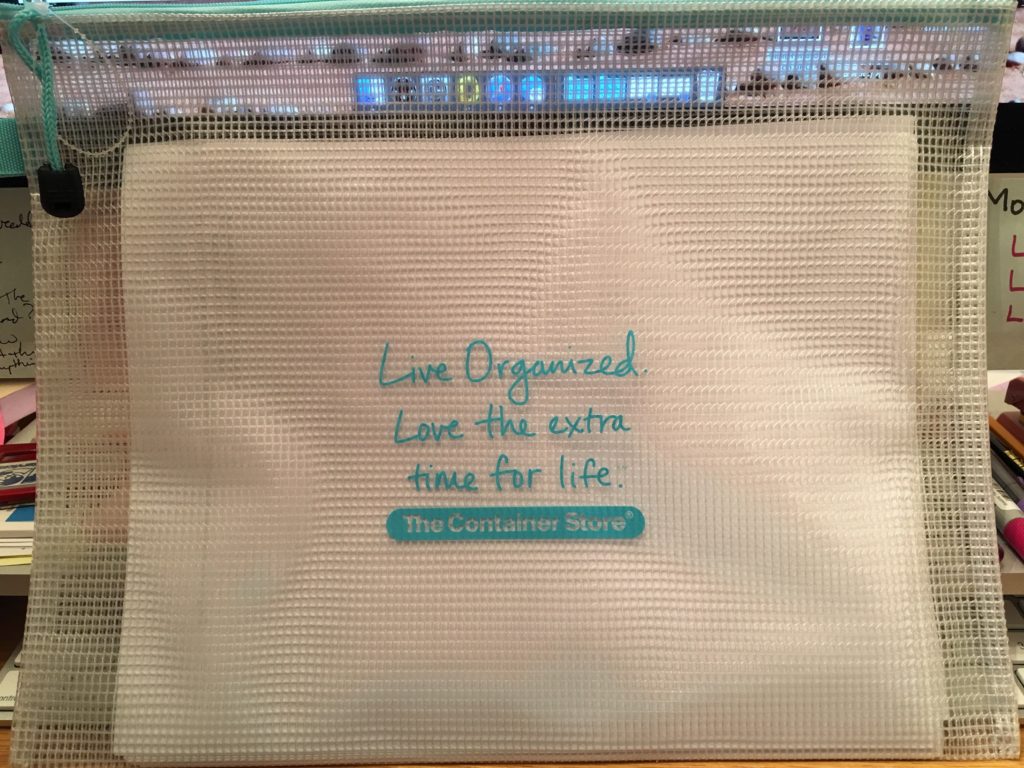
Others of our sponsors made sure we stayed hydrated and healthy. Brother quenched our thirsts by supplying these nifty water bottles we could hang from our pinkies while schlepping across the “campus” between sessions.
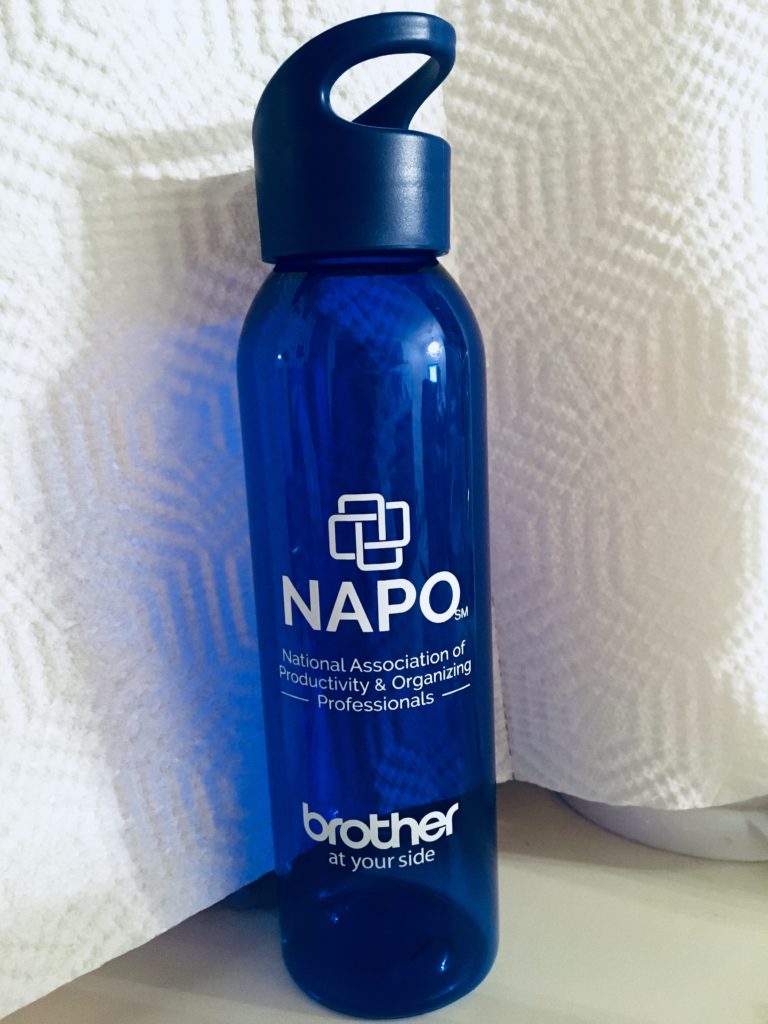
Meanwhile, RXBar, a company that makes “whole food protein bars” in 15 different flavors (using egg whites, dried fruits, nuts, and dates, and just one or two other natural ingredients, provided bars for munching. (I got Blueberry!) And our own Denslow Brown of the Coach Approach for Organizers made sure we had some Emergen-C, just to make sure we didn’t get run down!
BUT WAIT, NO PAPER ORGANIZING PRODUCTS?
Although we did not have an expo this year, our friends at Smead (one of our two major NAPO2018 conference sponsors, along with Brother) knew that I couldn’t survive a NAPO conference without getting to hold organizing supplies in my hand. So, with great foresight, Smead brought our favorite people and some (new) favorite products. Coming up soon, we’ll delve into the newest and niftiest of what Smead had to show us.
NAPO2018: Paper Doll Reports from the Retreat

As I reported last time in NAPO2018: Advancing at a Retreat, this was not set to be our usual annual conference and expo. Indeed, there was no expo, and the atmosphere was more of a sleepaway camp than a high-rise hotel conference.
BACK TO SCHOOL
The grounds of the Q Center, a former college campus, were beautiful, with little lakes and fountains dotting the vista.

However, if you recall your own halcyon college days, you may also remember rooms more like the saddest staterooms on the Love Boat and less like luxury hotel suites. (See below for Paper Doll‘s cozy quarters.)

That said, the plentiful food was delicious, and NAPO members came from throughout the United States, as well as from everywhere across the globe, with a healthy accent on our organizing friends from Central and South America.
Food and tiny beds aside, we NAPO members flock to our conferences for the camaraderie and education, and both were in full force this year. After a leadership event for chapter and committee volunteers, NAPO2018 opened with a keynote address from therapist, coach, and speaker Jessica Butts on how to “Live Your Life from the Front Seat,” a rousing presentation on capitalizing on your best attributes while understanding and making the most of your Myers-Briggs (personality) Type Indicator (MBTI).
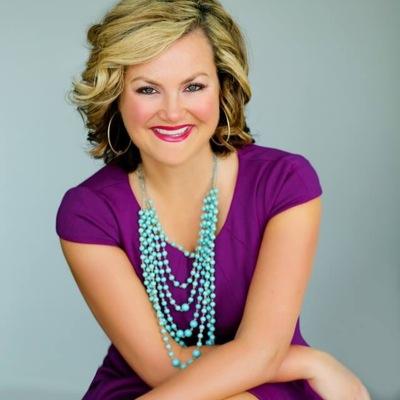
ON THE RIGHT TRACK
There were four main educational tracks for this year’s retreat format, most reflecting a slight change in focus (less technology and professional development, more self-care and self-growth) vs. other years. Certainly, we did have some traditional coursework. For the Business Growth track, attendees’ options included:
- Oh, the Places You Can Go! The Life Cycle of a Professional Organizer
- How to Streamline Your Business Marketing
- Build Success with and Gain Chronic Disorganization Clients When You Develop and Use a Collaborative Network
- Quickbooks Efficiency 101: How to Save Tons of Time
- Grow Your Business with Employees, Subcontractors, Mentors & Virtual Assistants
- Leads Inspiring Leaders: Winning Strategies for Personal and Business Growth
For the pure Organizing Education track, we could take sessions entitled:
- Opening Doors to Sustainability – Environmentally Conscious Organizing: Simple Sustainable Secrets for You and Your Clients.
- Transform You & Your Kitchen for Healthier Eating: How to Create a Functional Kitchen & Eat Well
- In Five Minutes or Less, Would Your Clients Be Ready for Anything?
- Multitasking Makes You Stupid: Discover the Myth of Multitasking and Learn the Powerful Effect of Focus Instead
- Behind the Scenes of the Successful Organized Family: Teaching Clients to Be the CEOs of their Households
- Microsoft Outlook: Beyond the Basics
Beyond these sessions, though, we had two intriguing tracks from which I selected the bulk of my classes. From the first, the Experiential track, I actually attended four of these six sessions:
- Space Planning for Professional Organizers
- From Inking to Accomplishment: How to (Finally!) Achieve That Big, Bold Goal
- Delivering an Experiential Workshop for Success
- Cultivating Creative Space with Vision Boards
- I’m OK, You’re a Complete Mystery! Discover the Owner’s Manual for Human Beings and Exponentially Improve Your Relationships with Clients, Prospects, and Beyond
- DIY Hand Tools for the Professional Organizer
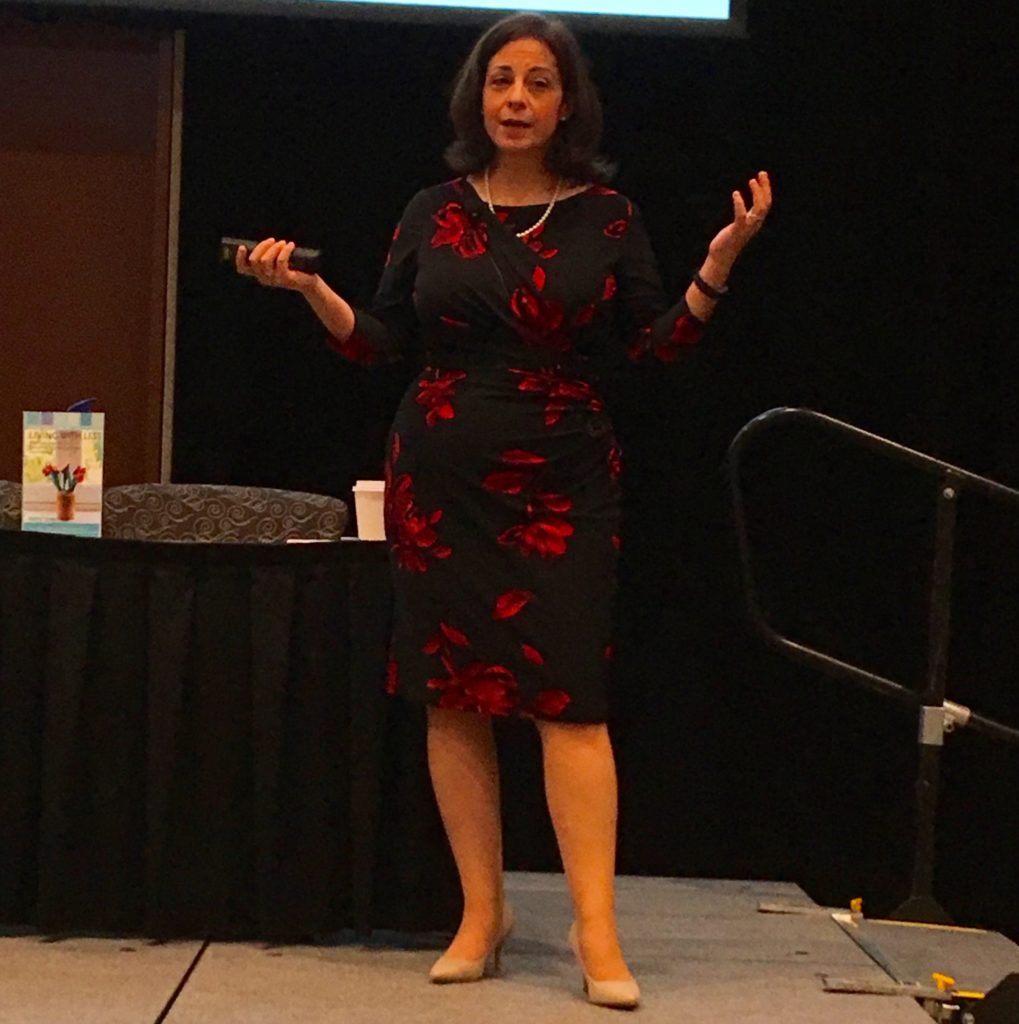
In “From Inkling to Accomplishment,” Kathy Vines, CPO® led us in group and one-to-one interaction to help us (and help us help our clients), turn our ambitious aspirations into goals we can actually achieve. We learned how to fight the “cocktail of self-doubt and perfectionism” and silence the negative self-talk that sometimes cuts us off at the pass.
We also had practical opportunities to break our dreams into small, actionable steps, identify sources of inspiration (to keep us motivated when self-doubt does creep in), and learn how to capture the knowledge and resources as they appear. Indeed, Kathy’s comment that we must all “prepare for the inconvenient epiphany” will likely have the starring role in a future Paper Doll post on capturing information beyond the typical notepads and Evernote suggestions.

NAPO’s Immediate Past President, Ellen Faye, CPO®, presented two sessions in one with “Delivering an Experiential Workshop for Success.” First, she taught us the core principles of a high-quality experiential workshop – creating a safe environment and using best practices to spark creativity and provide time for processing and integrating information. Then she actually presented an experiential session on creating a personalized “success formula” by helping us identify our core values and revamp our schedules to focus on work that reflects those values. It’s hard to describe in a paragraph, but (to bring in a prior lesson), inconvenient epiphanies were had, and eyes were opened!
In the session, “I’m OK, You’re a Complete Mystery,” Patty Kreamer, CPO®, provided a fascinating and energetic counterpoint to our opening keynote on the Myers-Briggs Type Indicators. Patty taught us about the DiSC Behavioral Style Model. In both cases, we learned how to identify our own styles and interpret our clients’ styles so that we might better communicate based on how they learn best and what they prioritize.

Most entertaining was the example Patty gave regarding Influencers (the little “i” in DiSC, also called Promoters). Patty referenced NAPO’s POINT community, an email platform, contrasting those who write brief, laconic responses vs. the chatty folks who write whole novels. For those of you who follow Paper Doll‘s lengthy blog posts, you won’t be surprised that I jokingly self-identified, raising and waving both hands. From the podium, Patty opined, “Yes, Julie, we know that’s you. Novels. But QUALITY novels!” As Patty taught us, understanding ourselves better is the first step toward becoming more effective when working with others.
My last session of the conference, and certainly the most experiential, was “DIY Hand Tools for the Professional Organizer,” taught by our colleagues Carol Jones and Roberta Andrade (the latter coming all the way from Brazil).
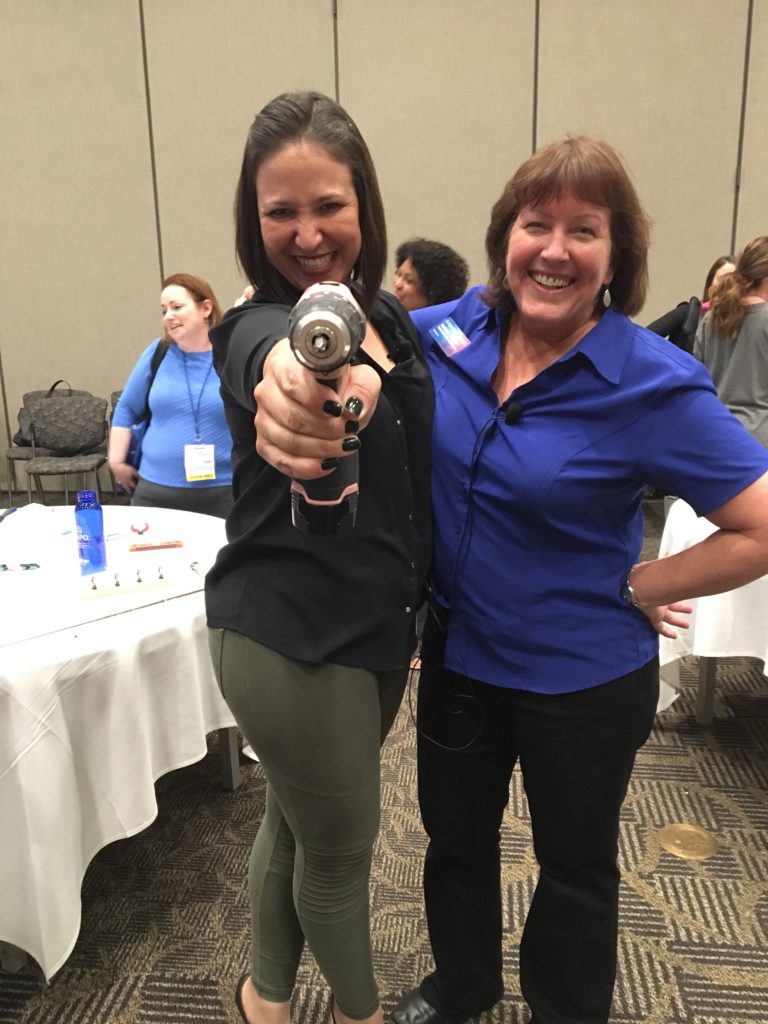
Having gone into the class not even knowing that sheetrock and drywall were the same things, literally everything in that class was new to me.
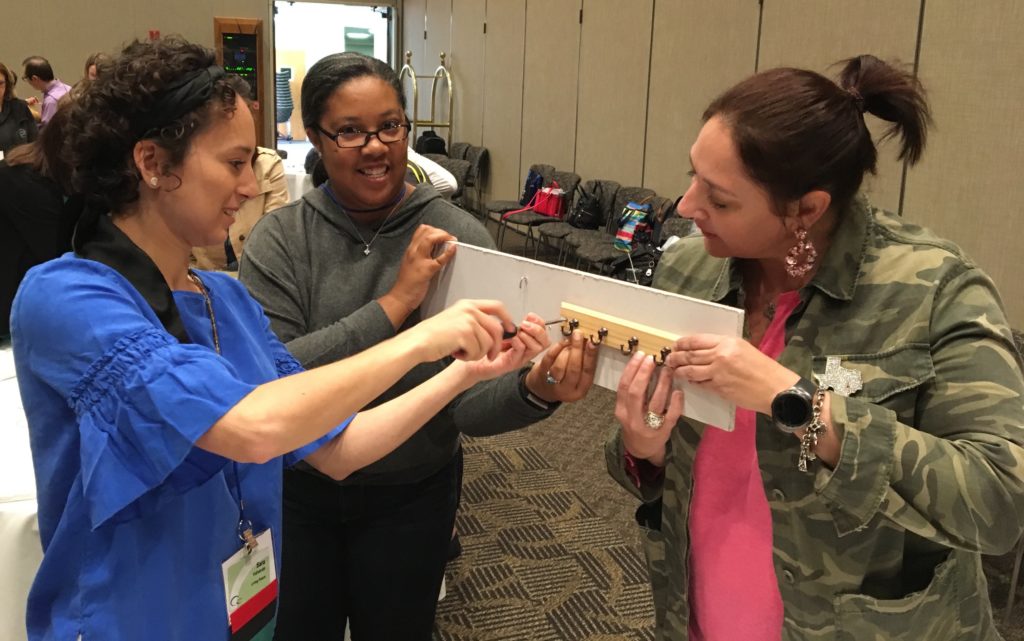
I got to use metal anchors to screw a hanging rack into drywall, learned the safety rules for using utility knives, and when to use a mallet vs. a hammer – hammers with nails, only, please! Perhaps the most useful thing I learned was how to easily insert Monkey Hooks in the wall to hang pictures – no hammers or nails needed.
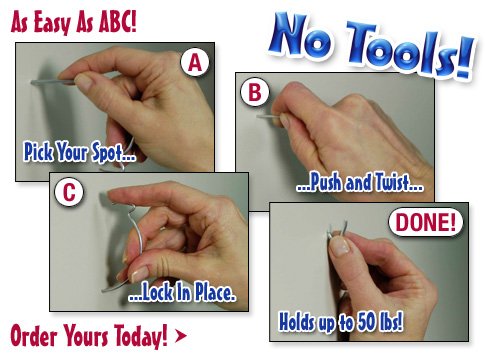
Our last track, and the one that most fit the concept of a retreat, was the Self-Care track. Professional organizers are as at risk (or more so) for burnout and overwhelm, and our clients are surely in need of guidance for self-care, so the sessions in this track were remarkably on-point. They included:
- Learn to Be Limitless: Silence Self-Doubt and Claim What’s Yours
- Organize My Own Day – Who’s Got the Time?
- Goodbye, Work-Life Balance. Hello, Better Boundaries!
- Simple Self-Care: Sleep. Create White Space. Walk.
- Yogic Tools for Organizers’ Needs
- Bringing Meditation and Mindfulness into Organizing and Productivity: Strategies for Self-Care and Work with Clients
In transformational coach Heather Vickery‘s “Learn to Be Limitless,” the curriculum seemed to have been built after peering in the windows of our group of high-achieving professional organizers and productivity consultants. We learned skills for setting better boundaries and communicating them more fully, reframing the limiting voices that stop us from achieving, and identifying the myriad ways to improve our own productivity and that of our clients, including the courage to delegate. As Heather said, “Just because you can do it all doesn’t mean that you should.”
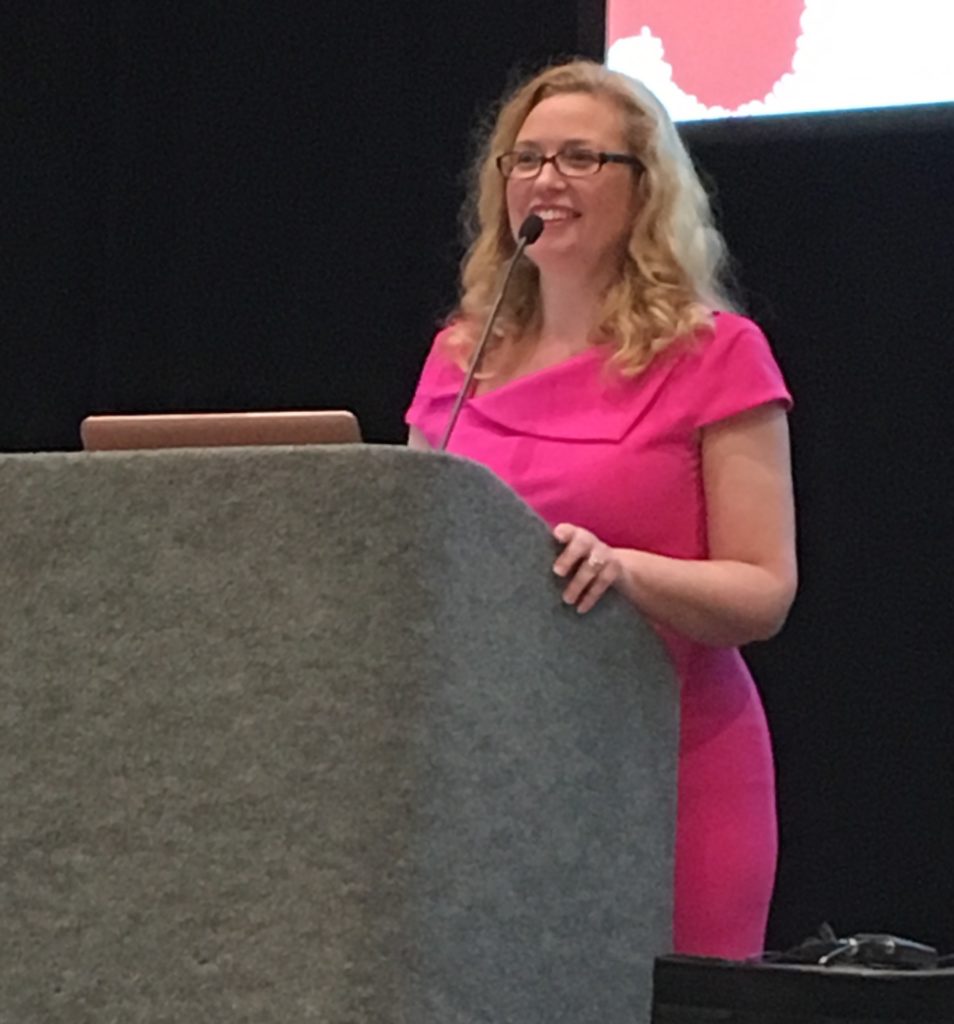
Heather also imparted some great life lessons for understanding how the willingness to be vulnerable and authentic can take us from fear-based to possibility-based decision-making and reminded us that the keys to our empowerment are in our own hands.
Ironically, “Simple Self-Care: Sleep. Create White Space. Walk.” was taught just after lunch and a long NAPO-wide meeting at the farthest outpost of the Q Center campus. Sluggish, we all took note that having too little white space in our schedule, too little sleep, and a stressful race-walk to the classroom meant the title of the session could not have been more appropriate.
Lisa Luken and Laurie Malloy presented a scientific research-based guide to the essentials of self-care and even provided a bibliography of resources to help us (and our clients) get enough sleep and increase the quality of it, eliminate overwhelm by increasing white space (both tangible and temporal), and use the power of walking, particularly in nature, to improve our creativity. The advice provided helped us hone our insight into what drains our energy vs. what allows each of us to gain energy. In fact, I’d have written this post days ago if I hadn’t committed to putting these lessons into practice, getting more sleep and injecting fewer tasks in my schedule! (So, blame Lisa and Laurie for the wait!)
OFF-TRACK BUT ON-POINT
The tracked sessions weren’t the only elements of this retreat designed to shake things up. For those able to face a 6:30 a.m. session, we had a variety of mind-body options, including yoga and “Claim Your Feminine Power: A Bellydancer’s Perspective on How to Lead, Love, and Live as a Woman (Without Losing Your Mind),” a title that did not seem to offend our small but loyal group of male colleagues. (I suspect the chance to sleep an extra hour and have a leisurely breakfast appealed to them as much as it did to me.)
Another option was “Applying Buddist Principles to Professional Organizing and Productivity Consulting,” a session that appealed to me intellectually, but – if you will allow me to mix spiritual practices – the spirit was willing, but the flesh was weak (and I slept right through that Sunday 6:30a option).
On Friday night, for those of us who managed to get through our dinners quickly, we had two alternatives: a follow-up session with our lively keynote speaker or “Unleash Your Inner Superstar.” I opted for the latter.
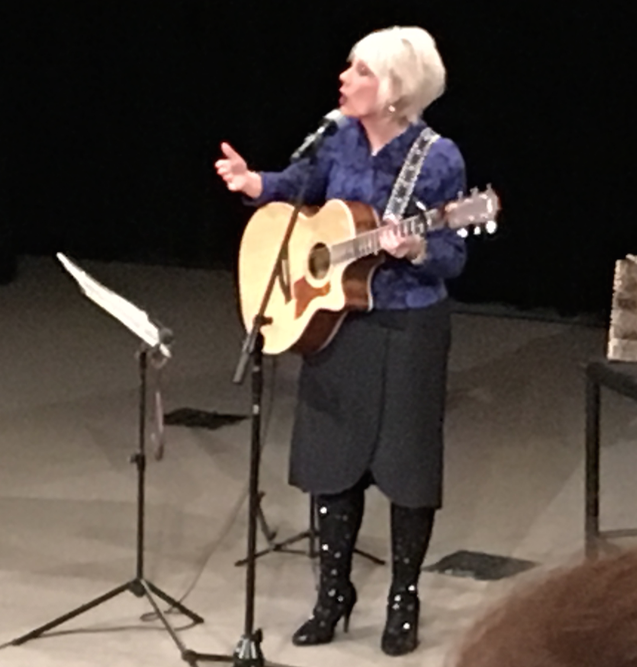
Little did we know that our demure colleague Lynn O’Dowd, CPO® would present a full-on Lady Gaga concert (with forays into an Aerosmith singalong) in service to teaching us how to quiet our self-doubt, push our limits, and (to use the words of a long-ago NAPO conference speaker), recognize our magnificence!

On Saturday, we had another set of special (but sadly, simultaneous) session options: “Learn How to Make Your Wardrobe and Personal Brand A Perfect Match” and “It’s All In Your Head: Harnessing the Power of Self-Talk.” I attended the latter, presented by Mary Fran Bontempo, and haven’t nodded in agreement or laughed so hard in a long time. In that session, we learned about how the language we use influences the way we feel, gained perspectives on coping with (scary) change, and got some commandments.
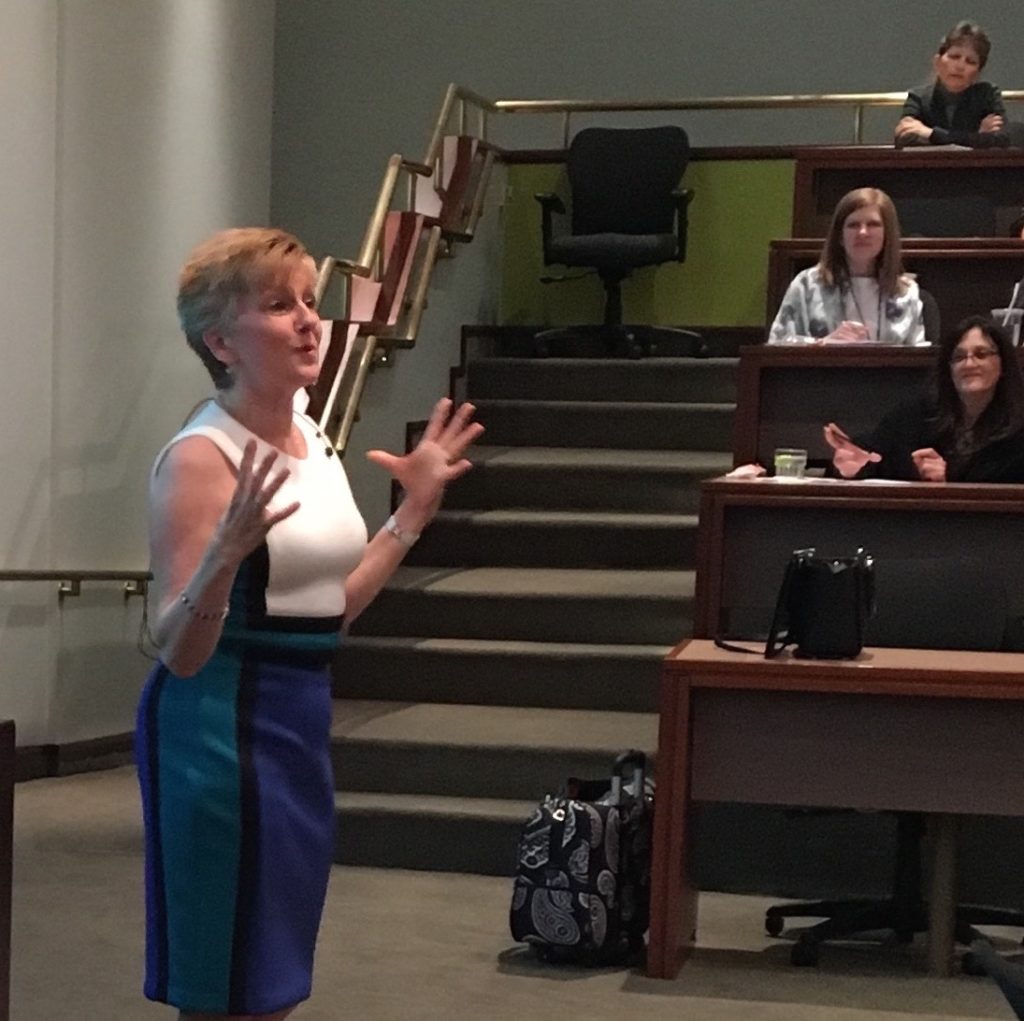
My favorite was, “Thou Shalt Ignore More,” referring to finding ways to keep everyday frustrations (from rude people to bad combovers) at bay by ignoring more of whatever really has very little to do with us. Expanding on a Sheryl Sanberg quote, Mary Fran wisely shared, “Before you can lean in to your own life, you have to lean out of everyone else’s.”
Lest you think we professional organizers are all work and no play, be assured that we were extremely well-fed at the Q Center’s all-inclusive and voluminous buffets, and we danced our way through our Saturday night President’s Reception. You’ve likely never seen anyone boogie along to Despacito and I Will Survive in such an efficient way!
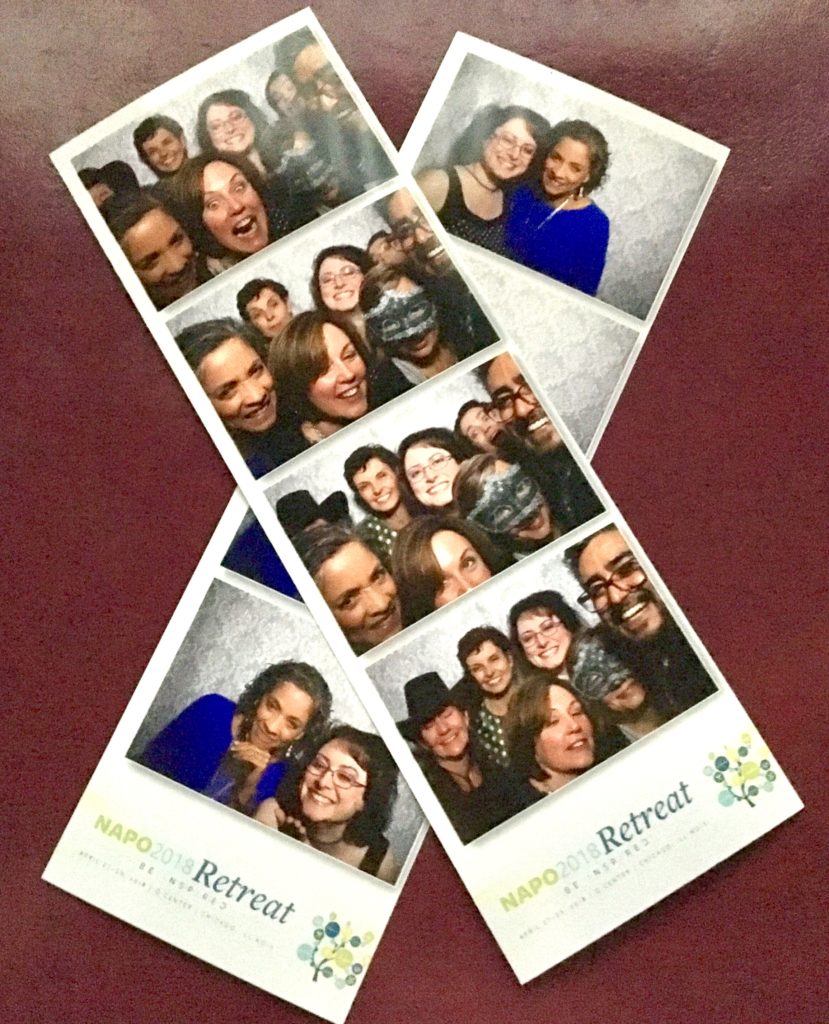
Next year for NAPO2019 in Fort Worth, Texas, we’ll be returning to a traditional conference with our favorite vendors in tow, but I suspect the success of the experiential and self-care tracks will live on longer than any bruises from bumping into walls in our tiny sleeping chambers.



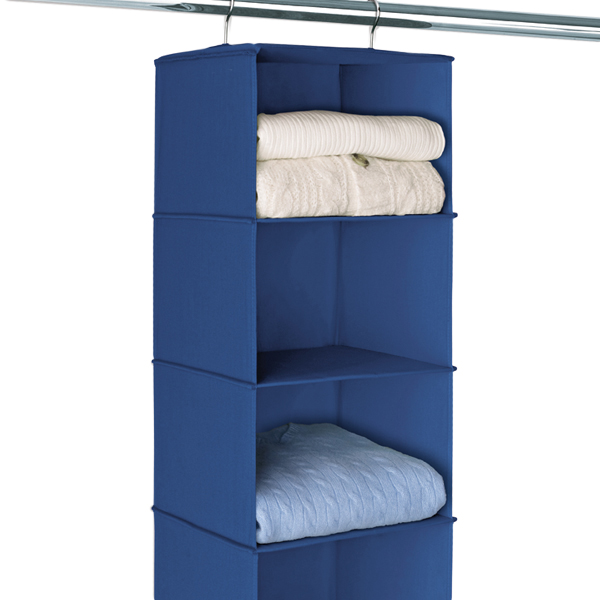
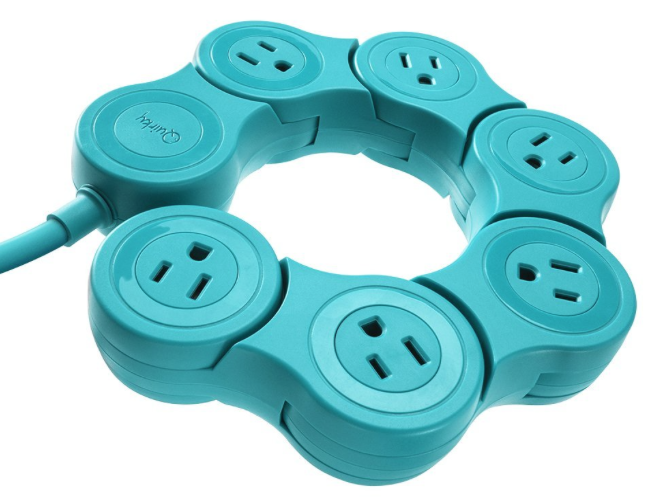
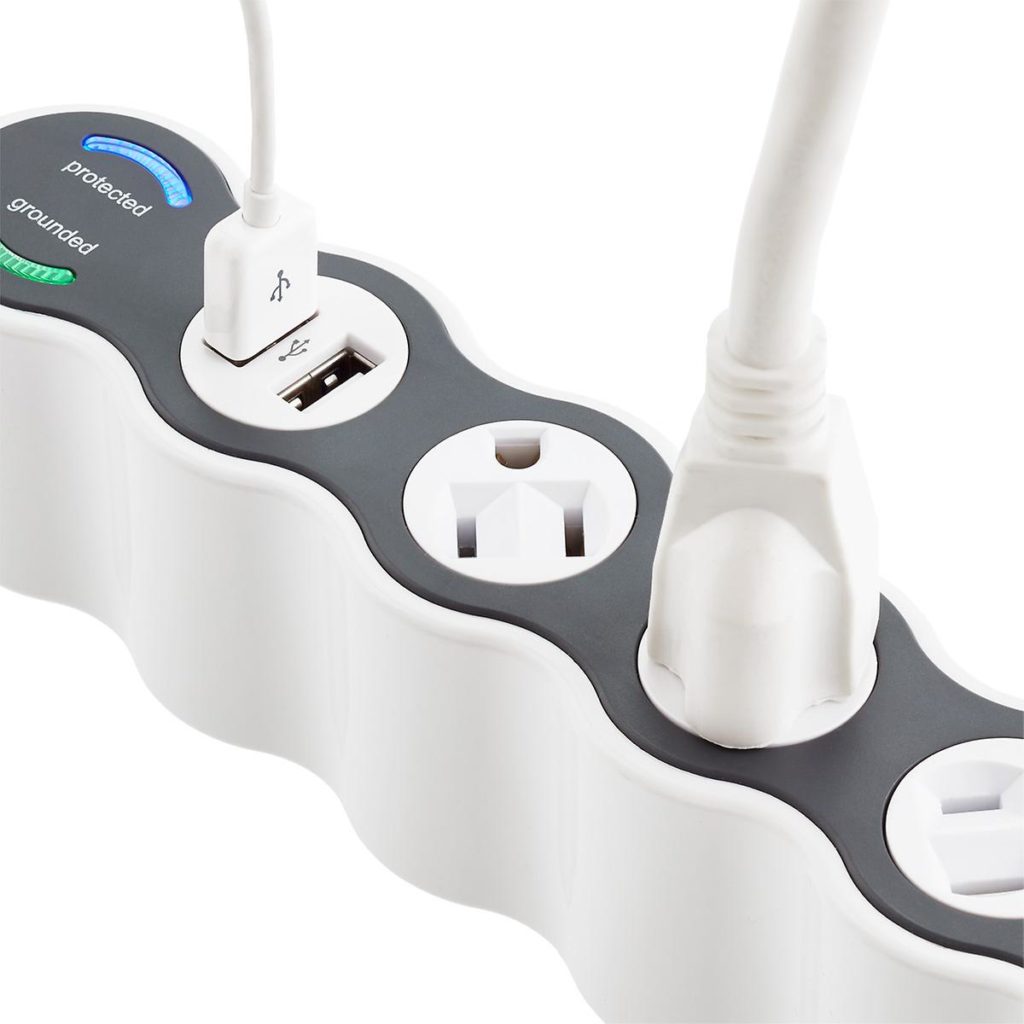
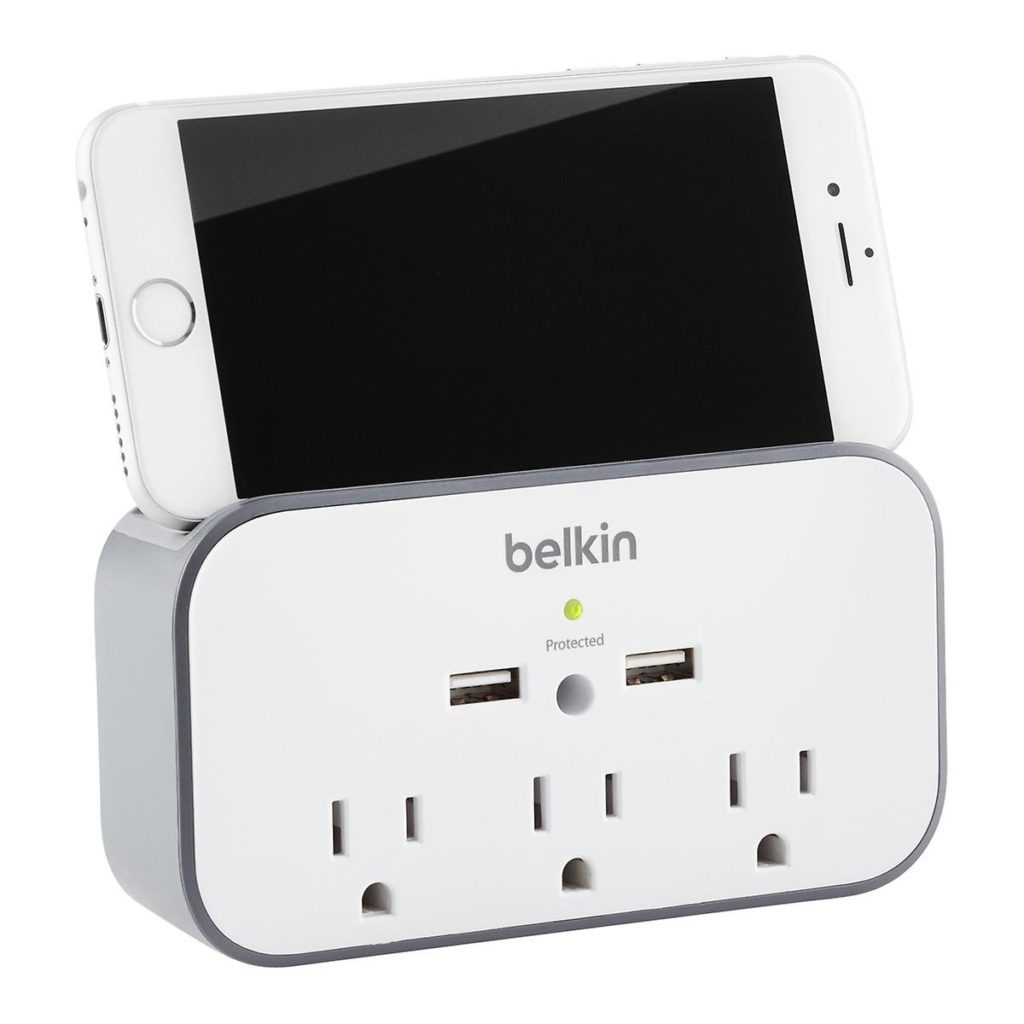
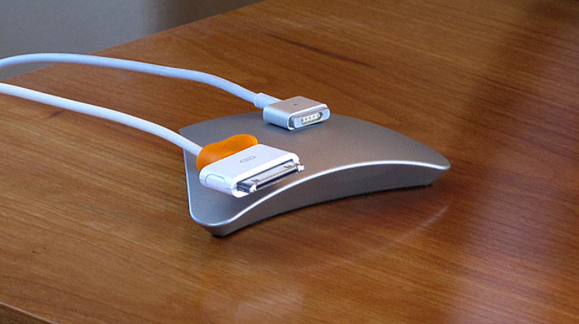
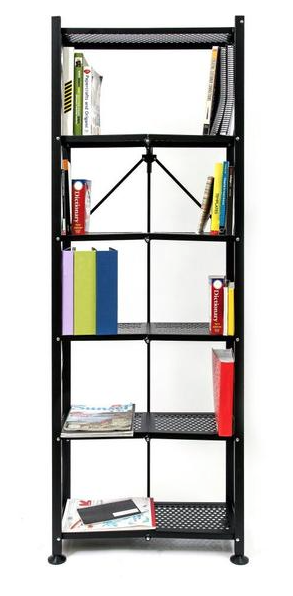
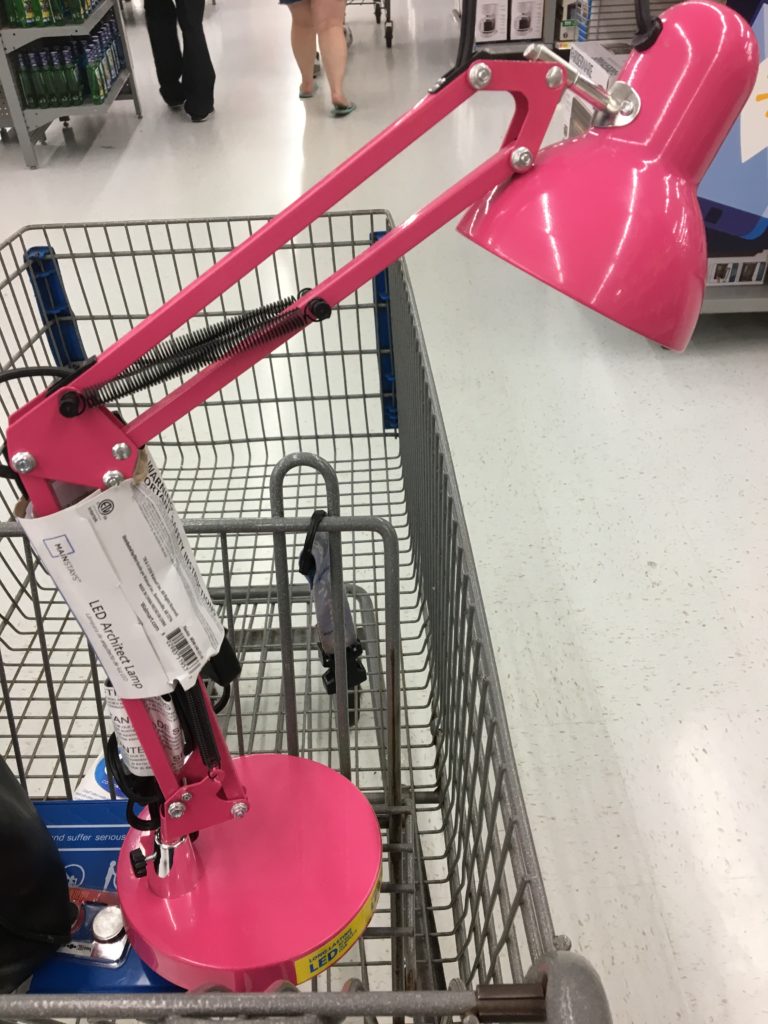



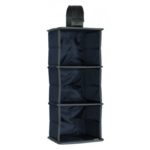
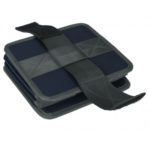



Follow Me